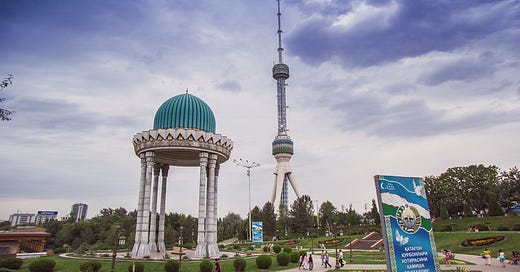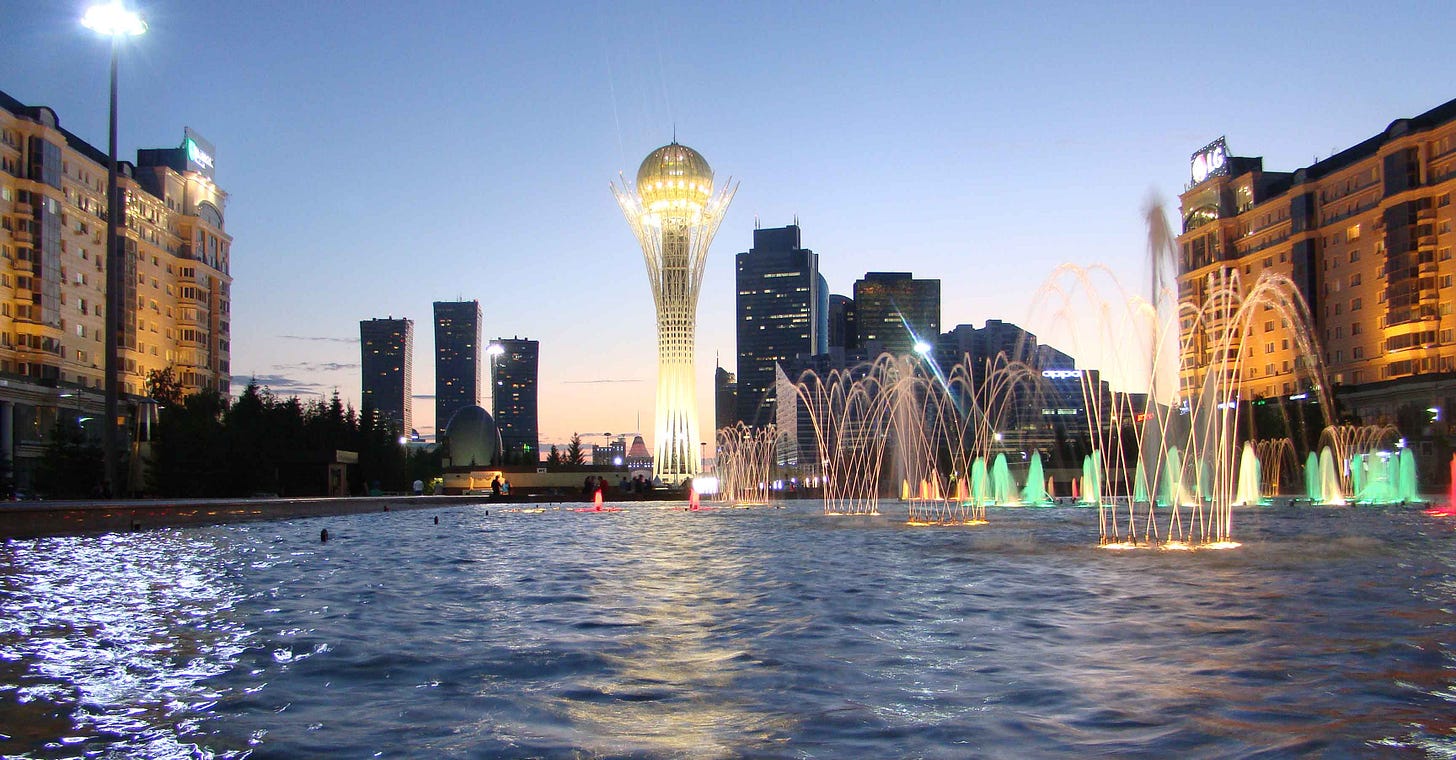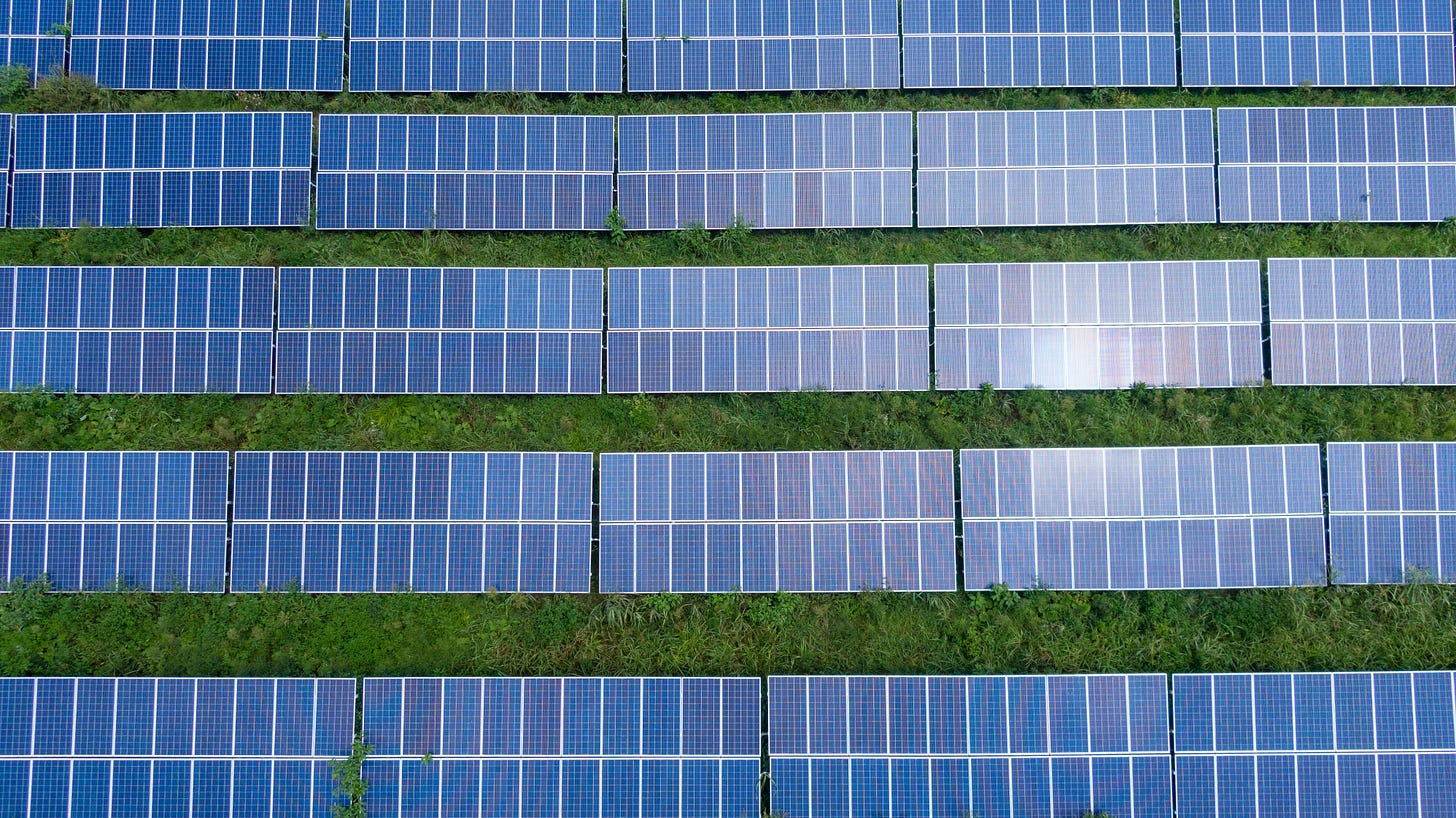The Steppe, from Montfort Eurasia - February 2024 edition
Montfort Eurasia's newsletter covering Central Asia and the Caucasus
Hello, and welcome back to The Steppe, the newsletter bringing you the latest business- and investor-relevant insights from the South Caucasus and Central Asia, brought to you by Montfort Eurasia.
In this edition, we take a look at:
Eurasia’s tech migration boom
Uzbekistan’s strategic export vision
Kazakhstan’s foreign investment drive
Armenia’s pivot to solar energy
Tajikistan’s growing railway traffic
Please don’t hesitate to contact us to share feedback and tips at eurasia@montfort.london.
Riding the tech migration wave: capitalizing on the IT influx across Eurasia
In the tech world's version of musical chairs, the South Caucasus and Central Asia have become some of the hottest seats. The region has experienced a surge of tech talent over the past two years, playing host to a wave of relocating Russian and Belarusian tech workers. Armenia, Georgia, Kazakhstan, Kyrgyzstan, and Uzbekistan have become popular migration destinations for these highly skilled, highly-mobile young people who bring disposable cash and skills with them.
Since Russia’s invasion of Ukraine, more than 50 multinational companies have moved their offices and staff from Russia to Kazakhstan alone. Notable among them is tech company InDrive, an international ride-hailing service. Armenia, too, has emerged as a popular destination, with Miro, the popular collaborative whiteboarding tool, choosing the country for its relocation.
The exodus of tech talent has sparked a competition among the region’s tech hubs. IT Park in Uzbekistan, Astana Tech Hub in Kazakhstan, and Engineering City in Armenia have quickly positioned themselves to leverage their growing capacity to attract and retain this valuable pool of professionals.
The impact of this tech migration is already reshaping local economies and societies. While it’s caused soaring property and rental prices, raising concerns among locals, their arrival also injects a substantial amount of cash and expertise into the region, creating new employment and investment opportunities.
The fact that tech workers and their companies can choose to be based more or less anywhere is a crucial aspect that distinguishes them from traditional migrants. The jobs they create are often high-paying, contributing to the formation of a rapidly burgeoning middle class.
The wave of well-paid tech workers means an expanded customer base for a range of businesses. Whether it's in the tech sector or other industries, the presence of a larger middle class can drive consumer spending, fueling economic growth in various sectors, including hospitality, tourism, property and leisure.
But are they here to stay? Well, that’s unlikely, say most experts, but countries can still find ways to make sure they’ve benefited from the migration shift even after it comes time for tech workers to move on.
We asked Anatoly Motkin, President of Strategeast, an NGO working to develop Eurasia’s digital economy, for his views on the influxes. He emphasizes the contribution these arrivals can make to the overall capacity of the local workforce:
“Each senior coder or developer that arrives trains and educates four or five junior developers annually. As mid-level or senior specialists, they develop local talent, thereby contributing to the sustainability and growth of the local IT sector.”
That could be transformative for economies across much of Eurasia. This knowledge transfer can have long-term impacts, retaining valuable skills within the country and reducing reliance on foreign expertise. Even if these tech workers stay for a short duration, Motkin says,
“they leave a lasting digital footprint by educating local talent who continue working for international clients and developing IT experts for their own countries.”
However, to harness the potential of these workers and the jobs they create, countries need forward-thinking policies that foster innovation and support entrepreneurship. Motkin suggests that governments, authorities, and universities should collaborate with the relocated tech companies to explore shared initiatives. Rather than pressuring developers, the collaboration should be natural, focusing on how companies can contribute beyond training and hiring local talent:
“These tech companies should think in terms of legacy, aiming to contribute to institutions in host countries and enriching the entire ecosystem beyond immediate workforce development.”
And, to ensure success in the long term, host nations across Eurasia must focus on creating an environment that fosters growth, innovation, and sustainability. The clock is ticking to transform this potentially one-time injection of cash and skills into a more sustainable force. If these countries fail to catch the tech wave quickly and implement effective policies, their tech bubble could soon burst for good.
Uzbekistan seeks to ramp up its exports
It’s a tough time to be an Uzbek trade official. President Shavkat Mirziyoyev has publicly expressed his concern over the country’s export volumes in recent months, replacing Deputy Investment, Industry and Trade Minister Badriddin Abidov, and firing a slew of local officials in a bid to shake up the country’s economic order book. According to Mirziyoyev, Uzbekistan should be exporting around 30 percent more than it currently does,
Despite Uzbekistan's efforts in recent years to position itself as a leading player in sectors like energy, minerals and textile production, Tashkent is determined to do more, particularly given the volume of foreign shipments decreased in four regions and two major industries last year.
One of the challenges lies in the fact that half of Uzbek exports go to just four countries: Russia, China, Kazakhstan, and Turkey - meaning the Central Asian nation is eager to diversify and find new partners. Uzbekistan joined the EU’s GSP+ preferential tariff arrangement in 2021, but exporters haven’t fully taken advantage of the range of goods covered by the scheme, according to the Uzbek government.
Another obstacle is the international certification of products, with less than 35% of enterprises in key industries meeting global standards.
President Mirziyoyev has now set ambitious goals, aiming to increase export volume to EU countries to $1.2 billion and nearly doubling the number of product categories exported to the EU. The plan includes implementing 1,700 international standards and 19 regulations by the end of 2024, along with transitioning 1,200 enterprises to global quality standards.
The Uzbek government is also looking to deepen its ties with China, with a view to becoming an export partner for Chinese firms. On a recent visit to China, which was a main focus of Uzbek media in recent weeks, President Mirziyoyev made a detour to Shenzhen to visit EV giant BYD, where joined the manufacturer’s CEO Wang Chuanfu in watching the launch of a BYD plant in Jizzakh. This comes with the right to export Uzbek-manufactured BYD vehicles in Central Asia.
While some may view this as welcome state focus on exports, others might interpret it as a sign that free-market reforms haven’t had the desired impact. As Uzbekistan strives to become an industrial, high-middle income country at a time of geopolitical insecurity its diversification of trade partners will be key. The scrutiny will be on its commitment to reforms and promotion of private-sector-led growth, as investors and entrepreneurs consider the country for potential partnerships and business opportunities.
The Kazakh comeback
Kazakhstan is one of Eurasia’s largest and most resource-rich nations, and for years has punched well below its weight when it comes to global trade. Coinciding with a raft of IPOs including app company Kaspi, which raised US$1bn, and flag carrier Air Astana which at the time of writing is shortly set to float in London, the government has launched a wave of new initiatives designed to bring in foreign investment and give it enhanced access to global markets.
Later this year, the country will roll out the National Digital Investment Platform, to complement the new Investment Promotion Council it created at the end of 2023. The digital investment platform aims to improve the investment climate and facilitate the implementation of projects in Kazakhstan.
Led by the Investment Committee of the Ministry of Foreign Affairs, the Eurasian Development Bank, and National Information Technologies JSC, this platform aims to streamline investor onboarding through a "one window" approach, speeding up project implementation and improving data exchange, making it a key tool to attract more foreign investment, even amid geopolitical challenges.
Kazakhstan’s commitment to economic transformation, reflected in its shoutout by the FDI Standouts Watchlist for 2024, aligns with its aspirations to diversify its economy from oil and gas.
Wary of not playing an unusually large and intrusive role in the economy, deputy prime minister and foreign minister of Kazakhstan Murat Nurtleu recently stated that his government’s agenda “includes plans for the privatization and stock market listing of a number of state companies, particularly in non-core sectors, to enhance market efficiency.”
As Kazakhstan strives to become a global investment hub, ongoing reforms, improved governance, and collaborative efforts are crucial for sustained investor appeal and the realization of the country’s ambitions.
Armenia's sun strategy
Armenia is strategically pivoting toward solar energy as fears of energy price instability loom due to worsening political relations with its primary energy supplier, Russia. The move is aimed at diversifying Armenia's energy sources, reducing external vulnerabilities, and promoting long-term sustainability.
Despite progress in renewable energy, particularly through hydropower, a significant portion of Armenia's electricity still relies on fossil fuels – mainly gas, oil and coal sold by Moscow. Recent geopolitical relations with Russia have prompted Armenians to expedite the shift towards alternative and sustainable energy to mitigate potential energy price fluctuations. Notably, they have been buying up and installing increasingly affordable solar panels for heating, both in the capital and the various regions of the country.
Renewable energy in Armenia has gained political significance. The European Parliament, in a recent resolution on EU–Armenia relations, urged Armenian authorities to accelerate the development of renewable energy, emphasizing the need to diversify energy sources as Russia still supplies over 80% of Armenia's natural gas imports. Indeed, the EBRD recently announced its backing of a Yerevan solar panel manufacturer, noting reducing China’s dominance of solar panel manufacture in its publicity, and an EBRD and EU-backed fund made its first investment in Armenian solar power back in 2021.
It’s not just the EU that’s taken an interest, however – Emirati renewables company Masdar is building Armenia’s largest solar plant Ayg-1, which is scheduled to come online next year.
In 2023, solar power represented only 2.7% of the electricity generated in the country, highlighting the untapped potential for further growth. There is 72% more solar energy flow per square metre in Armenia than in Europe, according to the IEA.
As Armenia confronts energy security concerns, the gradual transition to renewables, and in particular, solar energy, not only addresses immediate geopolitical pressures but aligns with the country’s sustainability commitments.
The move also promises a more resilient and diversified energy sector, ensuring stability in the face of evolving geopolitical dynamics and fostering a sustainable future for Armenia.
Tajikistan ups its infrastructure game
Tajikistan’s location between larger countries like Russia, China and Iran, has for centuries meant being at the heart of the ‘great game’. And, with much talk of the ‘Middle Corridor’ that would link Europe and East Asia through the Caucasus and Kazakhstan, Tajikistan is looking to up its game to cash in on the action.
Recent statistics show Tajikistan increased the volume of transportation on its rail network by almost ten percent last year, with companies increasingly reliant on its network to get their goods to market. This is particularly crucial as landlocked nations, including those in Central Asia, typically face higher transport costs and encounter more challenges in integrating into global markets, as pointed out by Paul Collier, Professor of Economics at Oxford University – and ever more salient with continued disruption to Suez shipping
Despite these hurdles, UNCTAD reports a six percent increase in investment flows to landlocked countries in 2022, with Central Asia leading this positive trend, and Tajikistan emerging as a pivotal player in the region’s trade and transit corridors.
Geopolitical challenges, particularly Tajikistan’s border with Afghanistan, present additional obstacles for the nation. However, efforts to improve trade security are underway, such as the UNODC-World Customs Organization (WCO) Global Container Control Programme (CCP). The CCP’s expansion in Tajikistan, focusing on training officers for new Port Control Units in strategic locations like Khujand and Khorog demonstrates an awareness of the importance of addressing this obstacle.
The combined impact of increased investment flows and cargo transportation, and strengthened trade security measures is set to improve the country’s economic landscape and could solidify Tajikistan's role as a key player in the region's trade and transit networks.
Stat of the month
Azerbaijan, a prominent player in the European energy sector, is strategically expanding its gas industry and strengthening its Southern Gas Corridor in response to depleting reserves in aging oil fields.
In 2023, Azerbaijan's oil and condensate production totaled 30.2 million tons, of which 25.2 million tons were exported. At the same time, natural gas production reached 48.3 billion cubic meters (bcm), with 23.8 bcm exported, marking a decline in oil production and a significant increase in gas production.
Our friends at bne IntelliNews have more on the story.
What we’re reading
After Us by Maria Gunko in EVN Report
Kazakhstan: Gender violence-themed horror breaks box office records by Joanna Lillis in Eurasianet










Do you have any analysis regrading US - CA trade? Seems like US 'pivot to Asia' hasn't gone all the way to CA yet.